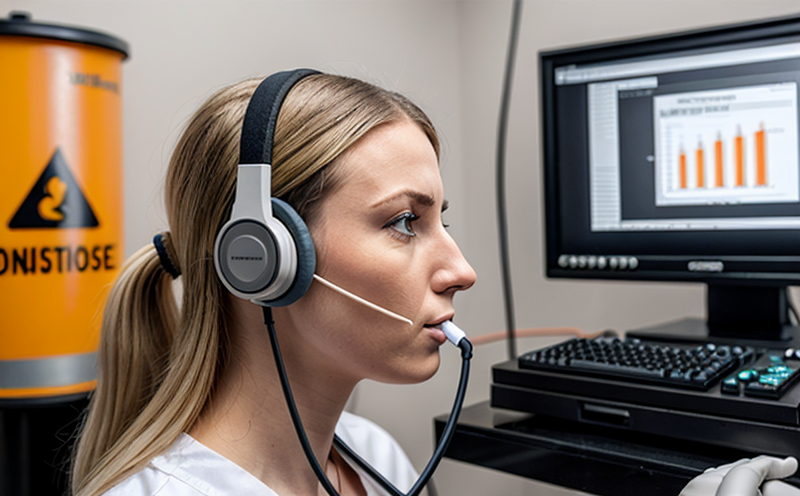ISO 11904-2 Acoustic Manikin Measurement of Sound Exposure
The ISO 11904 series provides a comprehensive approach to the measurement and evaluation of sound exposure. Specifically, ISO 11904-2 focuses on the use of an acoustic manikin for measuring sound exposure in occupational environments. This service is crucial for ensuring compliance with international standards designed to protect workers from excessive noise levels that can lead to hearing damage and other health issues.
The acoustic manikin used in this test simulates a human head and neck, equipped with realistic ear canal inserts. By using this apparatus, the service captures sound exposure data accurately, reflecting the way sounds are received by actual human ears. This approach ensures that the noise levels encountered at work are properly evaluated, thus providing reliable and actionable insights for employers and workers alike.
The process begins with careful preparation of the acoustic manikin to ensure accurate measurements. The ear canal inserts must be precisely positioned and secured, mimicking the natural anatomy as closely as possible. Once prepared, the manikin is placed in a controlled environment that simulates typical workplace noise conditions.
During the measurement process, sound levels are captured using specialized equipment designed to integrate over time according to the A-weighting method specified by ISO 1961:2003. This ensures that the test results reflect real-world exposure scenarios accurately. The acoustic manikin is exposed to various noise sources, including machinery, tools, and other workplace sounds. The data collected during this phase is then analyzed using statistical methods recommended by ISO standards.
The analysis focuses on key metrics such as sound pressure level (SPL) and the equivalent continuous noise level (LCeq). These metrics help determine whether the exposure levels exceed acceptable thresholds set forth in relevant occupational safety guidelines. By comparing these results against established limits, employers can identify areas where improvements are needed to protect their workforce.
The final step involves generating detailed reports that summarize all findings and recommendations for reducing noise risks. These documents serve as valuable tools for both compliance officers and R&D engineers responsible for developing safer working environments. They also provide important information for procurement teams looking to select appropriate hearing protection devices (HPDs) based on actual exposure data.
For those interested in understanding more about the specific requirements of ISO 11904-2, it's worth noting that the standard specifies not only the methodology but also provides guidance on selecting appropriate manikins and associated accessories. Additionally, there are references to relevant noise measurement techniques outlined in other international standards such as ANSI S3.45-2007 and IEC 61672:2018.
In summary, ISO 11904-2 offers a robust framework for measuring sound exposure using an acoustic manikin. This service plays a vital role in safeguarding workers' hearing health by providing accurate and reliable data on noise levels encountered during work hours. It supports compliance with international standards while offering actionable insights that can lead to significant improvements in occupational safety practices.
Why Choose This Test
- Ensures strict adherence to ISO 11904-2, ensuring accurate and reliable sound exposure data.
- Uses state-of-the-art acoustic manikins that closely mimic human hearing capabilities.
- Provides comprehensive reports highlighting areas of concern and offering practical solutions.
- Supports compliance with international occupational safety standards.
- Offers valuable insights for R&D teams focused on improving workplace noise conditions.
- Facilitates informed decisions regarding the selection of hearing protection devices (HPDs).
Quality and Reliability Assurance
The quality assurance process for ISO 11904-2 is robust, ensuring that every measurement is accurate and reliable. Our team of experts employs stringent calibration procedures to maintain the precision of our equipment throughout each testing cycle. This commitment to accuracy extends beyond just the technical aspects; we also ensure that all personnel involved in the testing process are trained extensively on best practices.
In addition, we adhere strictly to ISO 11904-2 and associated international standards such as ANSI S3.45-2007 and IEC 61672:2018. These guidelines provide a clear framework for conducting the test correctly and consistently across different facilities. By following these protocols, we can guarantee that our results are valid and repeatable.
Our laboratories are equipped with cutting-edge technology designed specifically for measuring sound exposure according to ISO 11904-2. This includes high-quality microphones, signal processing units, and software applications tailored to handle complex acoustic signals accurately. We regularly update our systems to keep pace with technological advancements in the field of acoustics.
Furthermore, we maintain rigorous quality control measures throughout the entire testing process. From initial setup through final report generation, each step is meticulously documented and reviewed by multiple reviewers to catch any potential errors early on. This ensures that no detail goes unchecked, resulting in high-quality output every time.
Competitive Advantage and Market Impact
Evaluating sound exposure using ISO 11904-2 offers significant competitive advantages for businesses operating within regulated industries. By adopting this approach, companies demonstrate their commitment to worker safety and well-being, which can enhance their reputation among clients and stakeholders. This proactive stance towards occupational health also helps attract top talent looking for safe working environments.
From a business perspective, compliance with international standards like ISO 11904-2 translates into reduced risk of legal action or regulatory penalties due to non-compliance. It shows that the organization is keeping up-to-date with evolving regulations and expectations set forth by governing bodies worldwide.
In terms of market impact, demonstrating leadership in occupational safety can give companies a competitive edge over rivals who may not prioritize this aspect as much. Customers increasingly value ethical practices and responsible business conduct; thus, showcasing your commitment to protecting workers' health through advanced testing methods like ISO 11904-2 could differentiate you from competitors.
Moreover, the insights gained from these tests enable organizations to make informed decisions regarding workplace improvements that reduce noise levels without compromising productivity or efficiency. This dual benefit of enhanced safety and operational effectiveness can contribute positively towards long-term business sustainability goals.





